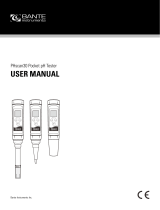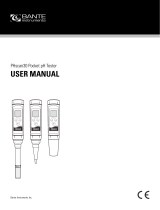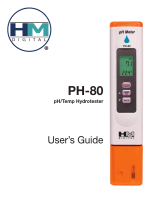Page is loading ...

INSTRUCTION MANUAL
pHTestr 10, 20, 30, 10BNC, Spear
Large Screen
Waterproof pH / Temperature Testr
Double Junction
Introduction
Thank you for selecting our waterproof pH Testr. This manual serves the following
(5) models:
• pHTestr 10 (Eutech PHTEST10 / 01X366901 / Oakton 35634-10)
• pHTestr 20 (Eutech PHTEST20 / 01X366902 / Oakton 35634-20)
• pHTestr 30 (Eutech PHTEST30 / 01X366903 / Oakton 35634-30)
• pHTestr 10BNC (Eutech PHTEST10BNC 01X366904 / Oakton 35634-14)
• pH Spear (Eutech PPHSPEAR 01X366920 / Oakton 35634-40)
This manual provides a step-by-step guide to operate the Testrs.
Before you begin:
Condition your pHTestr 10, 20, 30 electrodes by immersing it in electrode storage solution
or tap water for at least 30 minutes before use. DO NOT use de-ionized water.
Ensure that your pHSpear electrode is always soaked in the electrode storage solution or tap
water via its protective cap.
Note: For pHTestr10BNC, please refer to the pH electrode’s instruction manual.
pH Buffer Set Selection
Your Testr features USA (pH 4.01, pH 7.00 and pH 10.01) or NIST (pH 4.01, pH 6.86, and
pH 9.18) standards. Select either one to suit your requirements.
1. While pressing the HOLD/ENT button, switch on the Testr by pressing the
ON/OFF button.
2. Release the HOLD/ENT button. The display will flash either USA or NIST.
3. Press CAL button to toggle between the two buffer set standards.
4. Press the HOLD/ENT button to confirm the selection of the buffer set.
This Instruction Manual is also available for download on our Web-site: eutechinst.com or 4oakton.com
Figure 5: User Reset Sequence
With meter powered
off, press CAL and
ON/OFF at the same
time. First release
ON/OFF button, then
CAL button.
After reset, whole
LCD segment lits up
and goes back to
measurement mode.
Figure 4: Example of HOLD Function
3. Press the CAL button to enter calibration mode. The ‘CAL’ indicator will be
shown. The upper display will show the measured reading based on the last
calibration while the lower display will indicate the pH standard buffer solution.
Note: All Testrs have dual display during calibration mode
Note: To abort calibration, press the ‘CAL’ button.
4. Allow about 2 minutes for the Testr reading to stabilize before pressing
the HOLD/ENT button to confirm the first calibration point. The upper display will
be calibrated to the pH standard buffer solution and the lower display will then
be toggling in between readings of the next pH standard buffer solution.
5. Repeat with other buffers if necessary. Rinse electrode in tap water before
dipping into next buffer.
Note: The calibration mode allows you to perform up to three calibration points before returning
to the measurement mode automatically. However, if you opted to have only one or two
calibration points, simply skip the remaining calibration points by exiting to the measurement
mode by pressing the CAL button.
pH Measurement
1. Press the ON/OFF button to switch the Testr on.
2. Dip the electrode about 2 to 3 cm into the test solution. Stir and let the reading
stabilize. For semi-solid samples using pHSpear, rotation is ideal for sample contact.
CAUTION: Testing dry samples is not accurate and can lead to sensor damage
or breakage. Soils must be wet and free of particulates that may scratch the glass
sensor. Excessive force into dry samples can cause glass breakage.
3. Note the pH value or press HOLD/ENT button to freeze the reading. To release
the reading, press HOLD/ENT again.
4. Press ON/OFF to turn off Testr. If you do not press a button for 8.5 minutes,
the Testr will automatically shut off to conserve batteries.
HOLD Function
This feature lets you freeze the display for a delayed observation
1. Press HOLD/ENT button to freeze the measurement. A ‘HOLD’ indicator will be
displayed and the measurement will be frozen.
2. Press HOLD/ENT again to release the measurement. The ‘HOLD’ indicator will
not be displayed anymore indicating the held measurement is released.
With meter powered
off, press
HOLD/ENT
and ON/OFF
at the same
time. First release
ON/OFF button, then
HOLD/ENT button.
After buffer
selection,
whole LCD
segment lits up
and goes back
to measureme
nt mode.
Figure 1: Buffer Selection Sequence
To do a 1 point calibration
only, press CAL button at this
point to exit to the
measurement mode.
Otherwise, proceed to second
buffer for a second buffer for
a second point calibration.
To do a 2 point calibration only, press
CAL button at this point to exit to the
measurement mode. Otherwise,
proceed to third buffer for a third
buffer for a third point calibration.
After the third point calibration, the meter will
automatically return to the measurement
mode. At any point, an error message ‘Er. 1’
will be displayed momentarily if the confirmed
pH value is not within the pH calibration
window.
Figure 2: Example of pH Calibration Sequence
ATC - Automatic Temperature Compensation
(Only for pHTestr 10, pHTestr 20 and pHTestr 30)
Through its in-built temperature sensor, the measurement error due to the changes in electrode
sensitivity due to changes in temperature is compensated to give the actual pH reading of
the sample measured.
MTC - Manual Temperature Compensation
(Only for pHTestr 10BNC, pH Spear)
The MTC range is 0 to 50.0 °C (32.0 to122.0 °F). User reset will set temperature to default
value 25°C or 77°F.
While in the measurement mode,
1. Press the HOLD/ENT button to bring the Testr to the ‘HOLD’ mode.
2. Press the CAL button continuously to switch to the °C or °F mode setting
selection screen.
3. Release the CAL button to confirm your mode selection and the display will go to
the manual temperature calibration mode with the upper display flashing. The
upper display shows the adjustable temperature value and the lower display shows
the last set temperature offset.
4. Press the HOLD/ENT button to set the upper display to the temperature value of
your sample.
5. Once the setting is reached, release the HOLD/ENT button. The new value is
automatically confirmed and returns to the measurement mode if no button is
pressed after 5 seconds.
Notes: To exit this program without confirming the calibration, press the CAL button before
the automatic confirmation takes place.
pH Calibration
Calibration should be done regularly, preferably once a week. You can calibrate up to three
points using either the USA or the NIST buffer set standards.
1. Press ON/OFF button to switch unit on.
2. Dip electrode about 2 to 3 cm into the pH standard buffer solution.
User Reset
You can reset the pH calibration to the factory default by using the user reset function. Buffer
set selection and temperature user calibration (pHTestr30) are not affected by the user
reset function.
1. Switch off the Testr.
2. While pressing the ‘CAL’ button, press and release the ON/OFF button to enter the
‘User Reset’ selection menu. The screen will display ‘rSt’ on the bottom display with
a flashing ‘nO’ selection.
3. Use the ‘CAL’ button to toggle between ‘nO’ and ‘YES’ selection.
• nO deactivates reset selection
• YES activates the reset selection
4. Press the HOLD/ENT button to confirm the selection made.
5. If you have selected ‘YES’, the unit will show ‘CO’ momentarily and proceed to the
measurement mode with the calibration reset back to factory default value.
6. If ‘nO’ is selected, the unit will proceed to the measurement mode without any
calibration reset performed.
Part of Thermo Fisher Scientific

3 Bars indicates Battery is full (100%)
2 Bars indicates 50% of the battery life is left
1 Bar indicates 25% of the battery life is left
Blinking battery casing indicates the need to replace
batteries with fresh ones as specified by manufacturer
Electrode is not in contact with solution or electrode is
failing.
Replacement sensor is not connected properly to the
tester during sensor replacement
Measured pH value or temperature value (pHTestr30)
exceeds its specified maximum or minimum value
Blinking ‘ATC’, ‘Or’ or ‘Ur’ indicates that there is a short
or open circuit at the built in temperature sensor
Temperature calibration error of attempting to calibrate
tester to a value which is out of range or under range
pH calibration error of attempting to confirm a calibration
value which is not within the specified calibration window
Self-Diagnostic Messages
ErEr
ErEr
Er
.1.1
.1.1
.1
Low battery
indicator
Or / UrOr / Ur
Or / UrOr / Ur
Or / Ur
(Still)
Over range /
Under range
signal
AA
AA
A
TT
TT
T
C / Or /C / Or /
C / Or /C / Or /
C / Or /
Ur Ur
Ur Ur
Ur (Blinking)
ErEr
ErEr
Er
.0.0
.0.0
.0
Error
Message
Large Screen
pHTestr10 pHTestr20 pHTestr30
pHTestr
pHSpear
Testrs 10BNC
pH Range -1.0 to 15.0 pH -1.00 to 15.00 pH
Resolution 0.1 pH 0.01 pH
Relative Accuracy 0.1 pH 0.01 pH
Calibration Points Up to 3 points Up to 3 points
Buffer Set USA - 4.0/7.0/10.0 USA - 4.01/7.00/10.01
Standard Selection NIST - 4.0/6.9/9.2 NIST - 4.01/6.86/9.18
Calibration Window +/-1.0 pH (pH 4.0 +/-1.00 pH (pH 4.01 & pH 10.01),
(USA Buffer Set & pH 10.0), +/-1.50 pH (pH 7.00)
Standard) +/-1.5 pH (pH 7.0)
Calibration Window +/-1.0 pH (pH 4.0 +/-1.00 pH (pH 4.01 & pH 9.18),
(NIST Buffer & pH 9.2), +/-1.25 pH (pH 6.86)
Set Standard) +/-1.2 pH (pH 6.9)
Temperature No 0-50.0°C or
Display 32.0-122.0°F
Temperature Compensation ATC MTC
Temperature Resolution No 0.1 °C / °F
Temperature Accuracy No 0.5 °C / 0.9 °F No
Temperature Calibration No +/- (5°C /9 °F) 0-50.0°C or
Window from default value 32.0-122.0°F (MTC)
Auto Off After 8.5 minutes from last key press
User reset Yes
Non Volatile Memory Backup Yes
LCD Display Dual
Power Requirement 4 x 1.5V “A 76” micro Alkaline Batteries
Battery life More than 500 hrs
Operating Temperature 0 – 50 °C
Tester Dimensions 6.5 “L x 1.5”dia. (165 x 38 mm) 9.75 “L x
1.5”dia.
(247 x
38 mm)
Weight 3.25 oz (90 gm)
Penetrating electrode total length Not applicable 91 mm
Shaft length Not applicable 31 mm
Penetrating electrode Not applicable 12 mm
upper diameter
Shaft diameter Not applicable 7 mm
Tester Specifications
Temperature Calibration (Only for pHTestr 30)
From the measurement mode,
1. Press the HOLD/ENT button to bring the Testr to the ‘HOLD’ mode.
2. Press the CAL button for 3 seconds to switch to the °C or °F mode setting
selection screen. Pressing the CAL button continuously for 3 seconds allows you
to toggle in between the °C and °F mode setting selection screen.
3. Release the CAL button to confirm your mode selection and the display will go to
the temperature calibration mode with the upper display flashing. The upper
display shows the current measured temperature reading based on the last set
offset and the lower display shows the current measured temperature reading
based on factory default calibration.
4. Dip the Testr into a solution of known temperature and allow time for the in built
temperature sensor to stabilize.
5. Press the HOLD/ENT button to set the upper display to the temperature value of
the solution.
6. Once the new temperature setting is reached, the new value is automatically
confirmed and returns to the measurement mode if no button is pressed after 5
seconds.
Notes: To exit this program without confirming the calibration, press the CAL button before
the automatic confirmation takes place.
Continuous pressing of CAL button (about
3 seconds) to toggle between
temperature setting of degrees Celsius
and Farenheit
Release
CAL button
to start
entering
the new
temperature
During calibration, upper display will flash.
Press HOLD/ENT to increase offset up to
+5 °C (+9 °F) from default value. It will
roll over to -5 °C (-9 °F) from default value
and start increasing again.
When the
temperature offset
value is reached,
the new value is
automatically
confirmed if no
key is pressed
for 5 seconds.
Figure 6: Temperature Calibration Sequence ( Only for pHTestr 30DJ)
Electrode Maintenance
1. Before measuring soil pH with the pHSpear, wet your soil sample with distilled
water and ensure that the soil is free of particulates. Even though the pHSpear is
ruggedized, hard surfaces such as stones and pebbles can still cause breakage.
2. Rinse the electrode with tap water or electrode storage solution after each
measurement. Care has to be taken not to damage the sensor’s glass electrode
especially while rinsing the pHSpear penetrating tip electrode.
3. In aggressive chemicals, dirty or viscous solutions, and solutions with heavy
metals or proteins, take readings quickly and rinse electrode immediately afterward.
For the pHSpear, the remnants of the semi solid samples on the penetrating
electrode can be removed by rubbing it with some table salt and then rinsing. Mild
detergent can be used to wash the penetrating electrode clean.
4. If possible, keep a small piece of paper or sponge in the electrode cap – moistened
with clean water or electrode storage solution (NOT de-ionized water) – and close
the cap over the electrode. For pHSpear, ensure that the electrode is kept soaked
in electrode storage solution or tap water via its protective cap.
Electrode Replacement
You can replace the electrode module at the fraction of the cost of a new Testr.
When the tester fails to calibrate or gives fluctuating readings in calibration standards, you
need to change the electrode.
1. With dry hands, grip the ribbed Testr collar with electrode facing you. Twist the
collar counter clockwise (see picture A). Save the ribbed tester collar and
O-ring for later use.
2. Pull the old electrode module away from the Testr.
3. Align the four tabs on the new module so that they match the four slots on the
Testr (see picture B).
4. Gently push the module onto the slots to sit it in position. Push the smaller
O-ring fully onto the new electrode module. Push the collar over the module
and thread it into place by firmly twisting clockwise.
Note: It is necessary that you recalibrate your Testr prior to measurement after an electrode
replacement.
Applications
Water quality testing • pools • spas • aquariums • aquaculture • hydroponics • ecology
studies • water and wastewater treatment • boilers • steam generators • car washes
• sanitation plants • labs • food sectors and more!
Rlbbed collar
Rotate collar
away from you
Insert Electrode Module
Electrode Module
Large
O-ring
Small O-ring
Small Tab Large Tab
68X068042 Jun 10 Rev 7
Figure 8: Example of electrode module
fitting alignment
Figure 7: Removal of collar
from tester
Changing Batteries
1. Open battery compartment lid (with attached lanyard loop).
2. Remove old batteries; replace with fresh ones. Note polarity
Accessories
ItemItem
ItemItem
Item
EutecEutec
EutecEutec
Eutec
h Instrh Instr
h Instrh Instr
h Instr
umentsuments
umentsuments
uments
Oakton InstrOakton Instr
Oakton InstrOakton Instr
Oakton Instr
umentsuments
umentsuments
uments
OrOr
OrOr
Or
der Codeder Code
der Codeder Code
der Code
OrOr
OrOr
Or
der Codeder Code
der Codeder Code
der Code
pHTestr 10,20,30 replacement sensor PHSENSOR03DJ 35624-38
pHSpear replacement sensor PHSENSOR04 35634-50
Carrying Pouch pH Testr 10, 20, 30 ECPOUCH01 35624-45
Warranty
The waterproof Testrs are warranted to be free from manufacturing defects for 1 year and
electrode module for 6 months, unless otherwise specified. If repair, adjustment or replacement
is necessary and has not been the result of abuse or misuse within the time period specified,
please contact your local distributor for assistance.
Return of Items
Authorization must be obtained from your distributor before returning items for any reason.
When applying for authorization, please include information regarding the reason the item(s)
are to be returned.
Note: We reserve the right to make improvements in design, construction and appearance of
products without notice. Prices are subject to change without notice.
/





